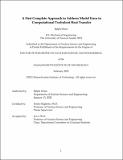A First Complete Approach to Address Model Error in Computational Turbulent Heat Transfer
Author(s)
Wiser, Ralph
DownloadThesis PDF (11.96Mb)
Advisor
Baglietto, Emilio
Terms of use
Metadata
Show full item recordAbstract
The challenge of turbulent heat flux has plagued the CFD modeling community for decades. A systemic dearth of adequate data has forced modelers to heavily rely on intuition and ad hoc reasoning to justify modeling choices. Many turbulence modelers believe that error in CFD temperature prediction stems from the simple turbulent heat flux model known as the Reynolds analogy. In particular, the Reynolds analogy is assumed to be inadequate for non-unity Prandtl fluids. However, engineers continue to use the Reynolds analogy in everyday heat transfer simulations, since no other approach has proven to be more general.
In the context of nuclear reactor engineering and licensing, a complete understanding and quantification of simulation errors is required. Since engineers continue use the Reynolds analogy for CFD heat transfer, which has widely accepted limitations, most users in nuclear vendor companies and regulatory bodies have little confidence in CFD temperature predictions. This lack of confidence heavily limits the uptake of CFD in nuclear engineering applications. Consequently, the benefits of CFD including reduced cost and project timeline have not been fully realized in the nuclear reactor engineering industry.
This thesis focuses on a holistic understanding of the sources of model error in turbulent CFD heat transfer simulations. While the Reynolds analogy is not a perfect model for turbulent heat flux, we find that other sources of error are more consequential. These include model error due to poorly resolved turbulent structures, model error due to the form and coefficients that represent turbulence anisotropy, model error in the buoyancy production of turbulence, and boundary layer model error. This understanding derives from dozens of simulations of legacy experiments, as well as comparison with a new DNS database developed by collaborators at other universities.
A first complete approach is proposed to address the important sources of model error in computational turbulent heat transfer. The methodology includes quantifying the model error in the turbulent momentum transfer model, which has a dominant effect on the temperature error. In addition, a new model for predicting buoyancy production of turbulence is included in the methodology. No special treatment of the turbulent heat flux is applied, i.e., the Reynolds analogy is retained. The components of the methodology are separately tested, then the complete method is assessed in a range of flow cases at different Prandtl numbers. This complete approach for temperature model error will increase confidence in CFD temperature predictions and could lead to higher CFD uptake in nuclear design. Further, it could contribute to regulatory acceptance of CFD in nuclear reactor licensing, which vendors see as a crucial step enabling licensing of advanced reactors such as liquid metal cooled and molten salt cooled reactors.
Date issued
2023-02Department
Massachusetts Institute of Technology. Department of Nuclear Science and EngineeringPublisher
Massachusetts Institute of Technology